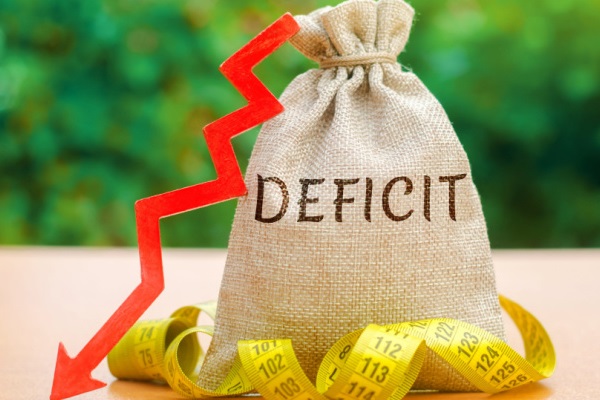Current Account Deficit – Formula, Calculation and Working

What is Current Account Deficit (CAD)?
A current account deficit is a situation where a country’s total imports of goods, services, and investments exceed its total exports of goods, services, and investments, resulting in a net outflow of currency from the country to foreign countries.
In other words, it is the difference between a country’s total payments to other countries and its total receipts from those countries in a given period, usually a year. The current account includes trade in goods and services, income from investments, and transfers, such as foreign aid.
A current account deficit can be an indicator of a country’s economic weakness, as it suggests that the country is consuming more than it is producing. However, it can also indicate that the country is borrowing money from foreign investors to finance its current consumption, which may be necessary for economic growth.
How Does a Current Account Deficit Work?
A country can reduce its existing debt by increasing the value of its exports.It can impose import limitations, such as tariffs or quotas, or it can focus on policies that encourage export, including import substitution, industrialisation, or policies that increase the global competitiveness of indigenous enterprises. Although having a current account deficit does not necessarily mean a country is spending beyond its means.A nation can maintain its financial stability if it uses its external debt to fund investments that provide larger returns than the debt’s interest rate.
Example of Current Account Deficit
A current account deficit occurs when a country imports more goods and services than it exports, meaning that it is spending more money abroad than it is receiving. This results in a negative balance of trade and can lead to a decrease in the value of the country’s currency.
For example, if a country spends Rs.100 crore on imports but only earns Rs.80 crore from its exports, it has a current account deficit of Rs.20 crore.
Formula to Calculate Current Account Deficit (CAD)
- Current account deficit formula : Current Account Deficit = Total value of Imports – Total value of Exports
The current account deficit is expressed as the difference between an economy’s net imports and exports. Since the current account includes variables like trade gaps, net current transfers, and net income from abroad, its deficit indicates a negative value.
Unlike BOP, CAD considers domestic capital flows. Hence, they can affect the flow of foreign exchange and can destabilise the economy.
How to Calculate the Value of Current Account?
From the Keynesian formula for GDP, we get
- Y = C + I + G + NIFA
, where national income or GDP is represented as Y, consumption as C, investments as I, and government expenditure as G. NIFA refers to net income from abroad.
To calculate the value of the current account, you can use the following formula:
- Current Account = NIFA + Net Current Transfers + Net Foreign Income
Thus, it is clear that the deficit in the current account affects a nation’s GDP and eventually affects its exchange rate. This indicates the inefficiency of fiscal stimulus to incentivise growth with higher debt levels.
How would a Large CAD Affect the Economy?
Normally, nations with high CAD indicate a fall in competitiveness and an overvaluation of their exchange rate. Countries with floating exchange rates can eventually restore their market competitiveness.
Following are some current account deficit problems:
1. Capital Flight
A high CAD indicates that investors lose interest owing to a strong devaluation in the currency. Eventually, this situation may lead to a decline in living standards and a lower boost for investments.
2. Depreciating Quality of Imports
A country may face an economic slowdown with greater dependence on imports over exports. Experts believe that while importing raw materials and capital goods indicates rising economic activity, importing commodities like gold and oil slows the economy. These commodities also cause greater negative externalities, which can cause market failure.
3. Pressure on Home Currency
A large CAD can cause a sharp fall in the value of a domestic currency. India has seen a sharp fall in the value of rupees owing to strong capital inflows and foreign direct investments. Unless the RBI intervenes in the foreign exchange market, Rupee may fall too low.
4. Depletion in Foreign Reserves
Experts believe that CAD indicates a strong depletion in an economy’s foreign reserves. India has seen a depletion of $572 billion in 2022 owing to aggressive intervention by the RBI. International economic and non-economic shocks also add to this fall.
Why Does CAD Matter?
Experts believe that a current account deficit of over 5% is detrimental to a nation’s economic health. A rapid rise in foreign currency demand indicates a home currency depreciation. Eventually, this situation may trigger inflation if the deficit is sustainably high.
However, deficits in the current account are not always causes of concern for policymakers, Dependence on foreign capital may indicate an actual need for financing domestic investments. Thus, the current account deficit does not harm domestic consumption if the economy is primarily driven by the private sector.
But a huge current account deficit indicates an unsustainable economy primarily due to a rise in borrowing. Nations like Russia, Brazil and several African countries have faced massive current account deficits owing to their inability to pay foreign debts.
Nations engaging in capital inflows to finance these deficits have eventually faced currency devaluation and increased mistrust among investors.
Also Read
Difference Between Current Account Deficit and Trade Deficit
| Current Account Deficit | Trade Deficit |
| The current account deficit is a broader measure of a country’s trade balance that includes not only goods but also services, income flows, and transfers. | A trade deficit refers specifically to the diff+erence between a country’s imports and exports of goods. It measures the balance of trade in physical goods, such as raw materials, finished products, and machinery |
| Includes all visible goods and services and unilateral transfer. | Includes only all visible goods. |
How to Deal with Current Account Deficit?
Economists and policymakers agree that when exports become cheaper, an economy can automatically reduce the deficit. Although it depends majorly on the elasticity of demand for exports and imports, a rise in aggregate demand can reduce inflation. Here are 3 potential solutions to dealing with CAD.
1. Currency Devaluation
When an intervention from the Central Bank causes devaluation in domestic currency, it raises the price of imported goods.
If demand is relatively elastic, this devaluation will cause a positive improvement in the deficit.
The Marshall learner condition states that devaluation will improve the economy if the combined elasticity of demand for exports and imports is higher than 1.
2. Contractionary Monetary Policy
A contractionary monetary policy will increase interest rates, thereby causing a fall in investments. This would eventually lead people to reduce their import consumption, thus improving CAD.
However, it can also reduce economic growth owing to a fall in aggregate demand. It may also cause a rise in long-run exports.
3. Protectionism
Most budding economies have resorted to protectionist economic policies by imposing tariffs and quotas. However, this policy is prone to retaliation by import partners and can also cause domestic industries to become uncompetitive.
4. Supply-side Policies
Governments can introduce privatisation and deregulation to increase their economy’s efficiency. This implies a gradual fall in production costs and a rise in exports.
Current Account Deficit Components
The current account deficit (CAD) is a measure of a country’s trade balance and represents the difference between its total exports and its total imports of goods, services, and investments. The components of the current account deficit include:
1. Trade Balance
This is the difference between a country’s total exports and its total imports of goods. A trade surplus occurs when exports exceed imports, while a trade deficit occurs when imports exceed exports.
2. Services Balance
This is the difference between a country’s total exports and imports of services, such as tourism, transportation, and financial services.
3. Income Balance
This is the difference between a country’s income received from abroad and the income it pays to foreign investors, such as profits, dividends, and interest payments.
4. Transfers Balance
This includes all transfers of money or goods between countries, such as foreign aid, remittances, and gifts.
Final Word
Despite the different policies related to switching and reducing the expenditure of a country, CAD poses a potential economic threat. The current rise in borrowing implies an outflow of Indian currency, pressuring the Rupee value. Unless countries adopt a floating exchange rate policy, a large value of the current account deficit can eventually destabilise the economy.
Looking for personal loan with Flexible EMIs and minimal documentation ? Navi cash loan is your answer, Download the app now and get instant approval and instant disbursal upto Rs.20 lakhs.
FAQs
India has seen a huge rise in trade deficits due to the outgo of investment income. Currently, the CAD for fiscal year 2021-22 amounts to almost 1.2% of India’s GDP.
A decrease in imports of commodities like gold and crude oil can potentially reduce CAD. India can also raise their exports, hedge currency, and promote ease of business to lessen the gap.
When CAD occurs as a surplus on the financial account, it can create employment and boost investment. Foreign investments can raise investors’ confidence and boost growth. A current account deficit can thus indicate a stronger economy, especially for countries with floating exchange rates.
A growing CAD can have a negative effect on a country’s exchange rate. It weakens the domestic currency, making imports more expensive than exports and vice versa. This affects the exchange rate considerably.
India’s current account deficit widened to $36.4 billion or 4.4 of GDP in the third quarter of 2022 from $18.2 billion or 2.2 percent of GDP in the second quarter.
Inflation,exchange rate, economic growth are the main causes of current account deficit.

Customer’s Feedback
No comments found.10 Best Bank for Savings Account in India [Highest Interest Rate 2023]
Savings account is a type of financial instrument offered by several banks. It lets you safely depo... Read More »What is Issuer Identification Number (IIN)- Working and Importance
What is an Issuer Identification Number (IIN)? Banks and financial institutions assign a distinc... Read More »What is a Vostro Account – Meaning, Working and Difference
What is a Vostro Account? A Vostro account is a bank account held by a domestic bank on behalf o... Read More »What is a Solvency Certificate? – Format, Documents Required & How to Apply Online?
What is a Solvency Certificate? A solvency certificate is a legal document furnishing the detail... Read More »What is Merchant Banking – Services, Features, Functions and Example
What is Merchant Banking? Merchant banking is a set of select banking and financial services off... Read More »Automated Clearing House: Objectives, Types and Process
Automated Clearing House is an electronic fund transfer network that manages automatic and direct... Read More »How to Redeem Credit Card Reward Points ?
Credit Card Reward points are types of incentives that customers receive when they use a credit car... Read More »What is Electronic Clearing Service (ECS) in Banking and How does it Work?
What is Electronic Clearing Service (ECS)? Electronic Clearing Service (ECS) is a method of elec... Read More »What are Credit Card Validators and How to Use them?
What is a Credit Card Validator? A credit card validator is a tool that checks the validity of a... Read More »What is Cash Management and How Does it Work?
Managing available capital can make sure that a small business stays afloat. Cash management is an ... Read More »What are Prepaid Expenses? – Definition, Examples, and Journal Entry
Prepaid expenses represent payments made in advance for products or services expected to be incurre... Read More »Increase Credit Card Limit – Important Tips and How to Do It?
The credit card limit is the maximum amount of money you can spend using your credit card. Your cre... Read More »Top 10 Chit Fund Schemes in India in 2023
Chit funds are one of the most popular return-generating saving schemes in India. It is a financial... Read More »10 Best Gold ETFs in India to Invest in April 2023
Gold ETFs or Gold Exchange Traded Funds are passively managed funds that track the price of physica... Read More »10 Best Demat Accounts in India for Beginners in 2023
Creation of Demat accounts revolutionised the way trades were conducted at the stock exchanges. It... Read More »20 Best Index Funds to Invest in India in April 2023
What is an Index Fund? An index fund is a type of mutual fund or exchange-traded fund (ETF) that... Read More »Best Arbitrage Mutual Funds to Invest in India in April 2023
Arbitrage funds are hybrid mutual fund schemes that aim to make low-risk profits by buying and sell... Read More »10 Best SIP Plans in India to Invest in April 2023
What is SIP? SIP or Systematic Investment Plan is a method of investing a fixed amount in ... Read More »10 Best Corporate Bond Funds in India to Invest in April 2023
Corporate bond funds are debt funds that invest at least 80% of the investment corpus in companies ... Read More »10 Best Bank for Savings Account in India [Highest Interest Rate 2023]
Savings account is a type of financial instrument offered by several banks. It lets you safely depo... Read More »





















